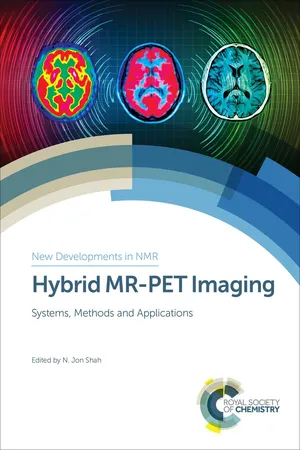
- 409 pages
- English
- ePUB (mobile friendly)
- Available on iOS & Android
About this book
The combination of two leading imaging techniques – magnetic resonance imaging and positron emission tomography – is poised to have a large impact and has recently been a driver of research and clinical applications. The hybrid instrument is capable of acquiring both datasets simultaneously and this affords a number of advantages ranging from the obvious, two datasets acquired in the time required for one, through to novel applications. This book describes the basics of MRI and PET and then the technical issues and advantages involved in bringing together the two techniques. Novel applications in preclinical settings, human imaging and tracers are described.
The book is for students and scientists entering the field of MR–PET with an MRI background but lacking PET or vice versa. It provides practical details from experts working in the area.
Frequently asked questions
- Essential is ideal for learners and professionals who enjoy exploring a wide range of subjects. Access the Essential Library with 800,000+ trusted titles and best-sellers across business, personal growth, and the humanities. Includes unlimited reading time and Standard Read Aloud voice.
- Complete: Perfect for advanced learners and researchers needing full, unrestricted access. Unlock 1.4M+ books across hundreds of subjects, including academic and specialized titles. The Complete Plan also includes advanced features like Premium Read Aloud and Research Assistant.
Please note we cannot support devices running on iOS 13 and Android 7 or earlier. Learn more about using the app.
Information
*E-mail: [email protected]
Nuclear magnetic resonance (NMR) is the technique that underpins magnetic resonance imaging (MRI) in its application in diagnostic medical imaging. Spin dynamics in NMR are described using a semi-classical model resulting in a net magnetisation, which is amenable to manipulation using radiofrequency pulses. The introduction of a spatially varying magnetic field, the magnetic field gradient, in the three orthogonal directions is introduced and it is shown how the application of gradients enables the selection of a physical slice and encoding of the two remaining in-plane dimensions. The concept of image encoding is then extended to 3D imaging. Beginning with a simple classical spin model, it is shown how the phenomenological Bloch equations can be derived and solved under the influence of particular field configurations. Eventually, the Bloch equations lead to the so-called signal equation and the introduction of the concept of a reciprocal space, the k-space, which is linked to real space by the Fourier transform (FT). Image reconstruction techniques going beyond the FT are also briefly touched upon to give the reader a fuller appreciation of modern, state-of-the-art MRI. In-plane acceleration methods operating both in k-space and in real space are described, as are multi-band acceleration techniques, which enable the acquisition of multiple slices simultaneously. Finally, a classification scheme, albeit a simple and incomplete one, is presented to enable the novice reader to gain an understanding of how order can be brought into the world of MRI pulse sequences.
1.1 Introduction
1.2 Physics of the Dynamics of Spin
1.2.1 Spin

Table of contents
- Cover
- Half Title
- Title
- Copyright
- New Developments in NMR
- Preface
- Contents
- Part A Basics Section I: Magnetic Resonance
- Chapter 1 Introduction to Magnetic Resonance Imaging 3
- Chapter 2 MRI Instrumentation 45
- Chapter 3 Selective Applications of MRI for the Brain 64
- Chapter 4 Ultra-high Field Imaging 101
- Chapter 5 Introduction to PET 131
- Chapter 6 Positron Emission Tomography Instrumentation 147
- Chapter 7 PET Quantification 162
- Chapter 8 Kinetic Modelling and Extraction of Metabolic Parameters 183
- Part B Hybrid MR-PET Imaging: technical overview Section I: Hardware
- Chapter 9 Introduction and Historical Overview 205
- Chapter 10 MR-PET Instrumentation 214
- Chapter 11 MR-based Corrections for Quantitative PET Image 231
- Chapter 12 Motion Correction in Brain MR-PET 259
- Chapter 13 MR-PET Measurement 275
- Chapter 14 Parametric Imaging 288
- Chapter 15 Technical and Methodological Aspects of Whole-body MR-PET 300
- Part C Human MR-PET Applications
- Chapter 16 Brain 319
- Chapter 17 Clinical Applications of Whole-body MR-PET 333
- Part D Preclinical Applications
- Chapter 18 Preclinical Hybrid MR-PET Scanner Hardware 353
- Chapter 19 Preclinical Applications of MR-PET 368
- Part E Tracers
- Chapter 20 Radiotracers for PET and MR-PET Imaging 381
- Subject Index